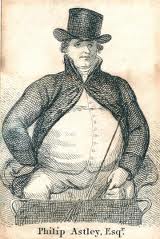Annotation:Astley's Hornpipe: Difference between revisions
Alan Snyder (talk | contribs) m (Fix HTML) |
No edit summary |
||
| Line 3: | Line 3: | ||
[[File:astley.jpg|200px|thumb|right|Phillip Astley]] | [[File:astley.jpg|200px|thumb|right|Phillip Astley]] | ||
<p><font face="garamond, serif" size="4"> | <p><font face="garamond, serif" size="4"> | ||
'''ASTLEY'S HORNPIPE'''. AKA and see "[[Ashley's Hornpipe (1)]]," "[[Bonnie Annie (2)]]." English, Hornpipe. England; Sussex, Shropshire, Lancashire. G Major. Standard tuning (fiddle). AABB. A very popular hornpipe found in a large number of English printed and manuscript collections. The name Ashley derives from the Old English name (still in use) for the ash tree coupled with the word leah, meaning glade or clearing, however, the title probably refers to Sergeant-Major Philip Astley, credited with creating the first circus in London in the second half of the 19th century (see note for "Astley's Ride"). It is unclear whether the title was originally "Ashley's Hornpipe" (under which it appears in the Thomas Hardy manuscript, for example) and later became associated with the famous equestrian and therefore underwent a slight name change through association. In print the earliest appearance seems to be in | '''ASTLEY'S HORNPIPE'''. AKA and see "[[Ashley's Hornpipe (1)]]," "[[Bonnie Annie (2)]]." English, Hornpipe. England; Sussex, Shropshire, Lancashire. G Major. Standard tuning (fiddle). AABB. A very popular hornpipe found in a large number of English printed and manuscript collections. The name Ashley derives from the Old English name (still in use) for the ash tree coupled with the word ''leah'', meaning glade or clearing, however, the title probably refers to Sergeant-Major Philip Astley, credited with creating the first circus in London in the second half of the 19th century (see note for "Astley's Ride"). It is unclear whether the title was originally "Ashley's Hornpipe" (under which it appears in the Thomas Hardy manuscript, for example) and later became associated with the famous equestrian and therefore underwent a slight name change through association. In print the earliest appearance seems to be in Thompson's '''Compleat Collection of 200 Fashionable Country Dances, vol. 5''' (1788, p. 41). Shropshire fiddler John Moore had it as "Astley's Hornpipe" in his 1837-40's manuscript. George Spencer (Leeds, Yorkshire) included both titles in his 1831 music manuscript. Fiddler, poet and writer John Clare (1793-1864, of Helpstone, East Midlands) had two versions in his music manuscript, both under the titles "Ashley's Hornpipe" and "Asley's Hornpipe" (one version generally corresponds to the "Ashley's Hornpipe" in the Hardy ms.). Likewise, under the "Ashley's" title it appears in the 19th century music manuscripts of G. Huddswell (Yorkshire) and William Mittell (Kent). In America, the tune was entered into the c. 1807-1840 '''Woburn Fife Manuscript''' (as "Astey's Hornpipe") and William Patten's c. 1800 copybook. | ||
<br> | |||
<br> | |||
Seamus Connolly remarks that he first heard "Astley's Hornpipe" on a Irish radio broadcast of Seán Ó Murchú's Céilí House program of the Eamonn Ceannt Céilí Band from Dublin, regularly featured on the program. Connolly says they had a penchant for playing tunes that were seldom heard. | |||
<br> | <br> | ||
<br> | <br> | ||
Revision as of 20:14, 3 April 2018
Back to Astley's Hornpipe

ASTLEY'S HORNPIPE. AKA and see "Ashley's Hornpipe (1)," "Bonnie Annie (2)." English, Hornpipe. England; Sussex, Shropshire, Lancashire. G Major. Standard tuning (fiddle). AABB. A very popular hornpipe found in a large number of English printed and manuscript collections. The name Ashley derives from the Old English name (still in use) for the ash tree coupled with the word leah, meaning glade or clearing, however, the title probably refers to Sergeant-Major Philip Astley, credited with creating the first circus in London in the second half of the 19th century (see note for "Astley's Ride"). It is unclear whether the title was originally "Ashley's Hornpipe" (under which it appears in the Thomas Hardy manuscript, for example) and later became associated with the famous equestrian and therefore underwent a slight name change through association. In print the earliest appearance seems to be in Thompson's Compleat Collection of 200 Fashionable Country Dances, vol. 5 (1788, p. 41). Shropshire fiddler John Moore had it as "Astley's Hornpipe" in his 1837-40's manuscript. George Spencer (Leeds, Yorkshire) included both titles in his 1831 music manuscript. Fiddler, poet and writer John Clare (1793-1864, of Helpstone, East Midlands) had two versions in his music manuscript, both under the titles "Ashley's Hornpipe" and "Asley's Hornpipe" (one version generally corresponds to the "Ashley's Hornpipe" in the Hardy ms.). Likewise, under the "Ashley's" title it appears in the 19th century music manuscripts of G. Huddswell (Yorkshire) and William Mittell (Kent). In America, the tune was entered into the c. 1807-1840 Woburn Fife Manuscript (as "Astey's Hornpipe") and William Patten's c. 1800 copybook.
Seamus Connolly remarks that he first heard "Astley's Hornpipe" on a Irish radio broadcast of Seán Ó Murchú's Céilí House program of the Eamonn Ceannt Céilí Band from Dublin, regularly featured on the program. Connolly says they had a penchant for playing tunes that were seldom heard.
Source for notated version:
a c. 1837-1840 MS by Shropshire musician John Moore [Ashman]; copied from Wilson's Companion to the Ballroom (1816) [O'Neill]; a c. 1847 music manuscript by Ellis Knowles, a musician from Radcliffe, Lancashire, England [Plain Brown].
Printed sources:
Ashman (The Ironbridge Hornpipe), 1991; No. 67, p. 27 (appears as "Astley's Hornpipe).
Connolly & Martin (Forget Me Not), 2002; pp. 12-13.
Loughran & Gammon (A Sussex Tune Book), 1982; No. 1.
Kerr (Merry Melodies, vol. 1); p. 42 (appears as "Hornpipe").
O'Neill (Waifs and Strays of Gaelic Melody), 1922; No. 332.
Plain Brown Tune Book, 1997; p. 42 (appears as an untitled hornpipe).
Thompson (Compleat Collection of 200 Favourite Country Dances, vol. 5), 1788; p. 41.
Trim (Thomas Hardy), 1990; No. 3.
Wilson (Companion to the Ball Room), 1816; p. 135.
Recorded sources:
Big Chain BC103, Cooper & Bolton – "The Savage Hornpipe" (2006).
